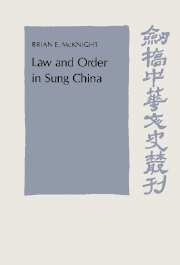Book contents
- Frontmatter
- Contents
- List of figures, maps, and tables
- Preface
- List of abbreviations
- 1 Introduction
- 2 The historical context
- 3 Crimes and criminals
- 4 Informal and semiformal agencies of law enforcement
- 5 Formal civil agencies of law enforcement
- 6 The role of the military in law enforcement
- 7 Supervision of law enforcement – the role of the intendants
- 8 Personnel selection
- 9 Urban crime and urban security
- 10 The Sung penal system
- 11 Jails and jailers in the Sung
- 12 Penal registration
- 13 The death penalty
- 14 Modifications of penalties
- 15 Conclusion
- Glossary
- Bibliography
- Index
2 - The historical context
Published online by Cambridge University Press: 23 December 2009
- Frontmatter
- Contents
- List of figures, maps, and tables
- Preface
- List of abbreviations
- 1 Introduction
- 2 The historical context
- 3 Crimes and criminals
- 4 Informal and semiformal agencies of law enforcement
- 5 Formal civil agencies of law enforcement
- 6 The role of the military in law enforcement
- 7 Supervision of law enforcement – the role of the intendants
- 8 Personnel selection
- 9 Urban crime and urban security
- 10 The Sung penal system
- 11 Jails and jailers in the Sung
- 12 Penal registration
- 13 The death penalty
- 14 Modifications of penalties
- 15 Conclusion
- Glossary
- Bibliography
- Index
Summary
Historical situation
In some fundamental ways traditional Chinese society was extraordinarily stable. At no time is this more striking than during the Sung dynasty. This was a time of startling technological innovations, of great creativity in the arts, sciences, and philosophy, a period during which the basic claim to political legitimacy was successfully challenged for centuries by the continuing presence of powerful Sino-foreign states to the north, a period of major population shifts and growth, and a period of enormous increase in both the numbers of urbanized areas and the urban character of the cities. And yet the structures of Chinese society, its basic values and attitudes, survived this kaleidoscope of intellectual and economic change, foreign competition, and scientific advance. Why? What were the strengths of the underlying social structures which allowed Chinese society to ride out centuries of radical change with relatively little alteration in the basic commitment to what it was to be Chinese? Certainly one element was the strength of those structures in Chinese society that were concerned with inducting new members (whether the young or significant outsiders) into the central traditions of the society. This crucial aspect of social control, the pattern of socializing people into being “Chinese,” is beyond the scope of this book. The subject of this work, the other side of social control, which buttressed socializing agencies by placing the weight of the law and law enforcement behind them, can be understood only against the background of the problems faced by the people of the Sung and the changes with which they had to wrestle.
- Type
- Chapter
- Information
- Law and Order in Sung China , pp. 34 - 66Publisher: Cambridge University PressPrint publication year: 1992



